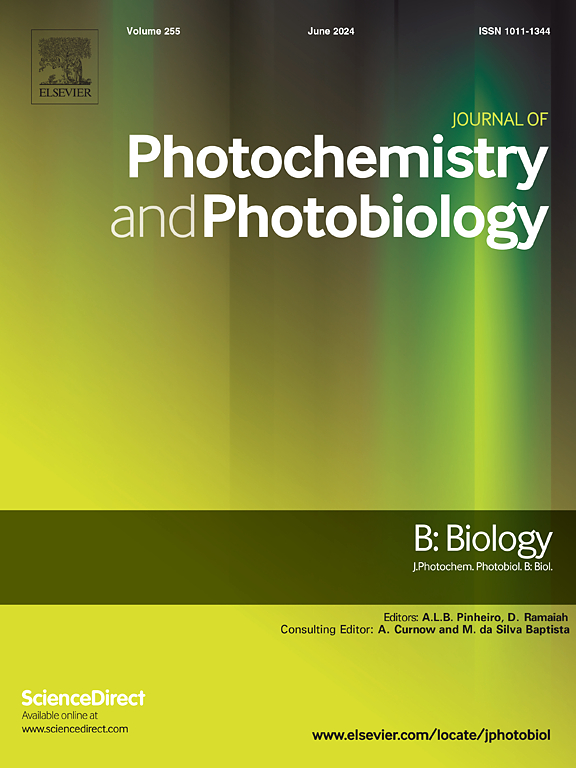Pulsed red light photobiomodulation ameliorates oxytocin-induced primary dysmenorrhea in mice by inhibiting oxidative stress and lipid accumulation
IF 3.7
2区 生物学
Q2 BIOCHEMISTRY & MOLECULAR BIOLOGY
Journal of photochemistry and photobiology. B, Biology
Pub Date : 2025-01-31
DOI:10.1016/j.jphotobiol.2025.113119
引用次数: 0
Abstract
Photobiomodulation (PBM) has gained attention as a kind of anti-pain or anti-inflammation therapy, yet its efficacy in mitigating the symptoms and underlying metabolic disturbances of primary dysmenorrhea remains underexplored. Here, 630 nm light reduced menstrual pain and prostaglandin F2a/prostaglandin E2 dysregulation, regulated oxidation and lipid peroxidation levels, and improved uterus damage in oxytocin-induced mice. Notably, pulsed wave (PW) treatment exhibited superior efficacy compared to continuous wave application. Hence, this research focused on the effects of 630 nm PW on oxytocin-induced mice by examining changes in the uterine transcriptome and plasma metabolome. Results from integrated analyses revealed significant modifications primarily in antioxidant and lipid metabolism pathways, alongside shifts in biomarkers related to arachidonic acid metabolism. Quantitative real-time PCR confirmed the downregulation of critical genes associated with oxidative stress and inflammation, as well as the suppression of uterine smooth muscle contractions and lipid overaccumulation. These findings support the potential of 630 nm PW PBM as a viable option for clinical interventions in dysmenorrhea management.
脉冲红光光生物调节通过抑制氧化应激和脂质积累改善催产素诱导的小鼠原发性痛经。
光生物调节(PBM)作为一种抗疼痛或抗炎症的治疗方法已引起人们的关注,但其在减轻原发性痛经症状和潜在代谢紊乱方面的疗效尚不清楚。在这里,630 nm光减轻了催产素诱导小鼠的月经疼痛和前列腺素F2a/前列腺素E2失调,调节氧化和脂质过氧化水平,并改善子宫损伤。值得注意的是,脉冲波(PW)治疗比连续波治疗表现出更好的疗效。因此,本研究主要通过检测630 nm PW对催产素诱导小鼠子宫转录组和血浆代谢组的影响来研究PW对催产素诱导小鼠子宫转录组和血浆代谢组的影响。综合分析结果显示,主要在抗氧化和脂质代谢途径中发生了显著变化,同时与花生四烯酸代谢相关的生物标志物也发生了变化。实时荧光定量PCR证实了氧化应激和炎症相关关键基因的下调,以及子宫平滑肌收缩和脂质过度积累的抑制。这些发现支持630 nm PW PBM作为痛经治疗临床干预的可行选择的潜力。
本文章由计算机程序翻译,如有差异,请以英文原文为准。
求助全文
约1分钟内获得全文
求助全文
来源期刊
CiteScore
12.10
自引率
1.90%
发文量
161
审稿时长
37 days
期刊介绍:
The Journal of Photochemistry and Photobiology B: Biology provides a forum for the publication of papers relating to the various aspects of photobiology, as well as a means for communication in this multidisciplinary field.
The scope includes:
- Bioluminescence
- Chronobiology
- DNA repair
- Environmental photobiology
- Nanotechnology in photobiology
- Photocarcinogenesis
- Photochemistry of biomolecules
- Photodynamic therapy
- Photomedicine
- Photomorphogenesis
- Photomovement
- Photoreception
- Photosensitization
- Photosynthesis
- Phototechnology
- Spectroscopy of biological systems
- UV and visible radiation effects and vision.

 求助内容:
求助内容: 应助结果提醒方式:
应助结果提醒方式:


